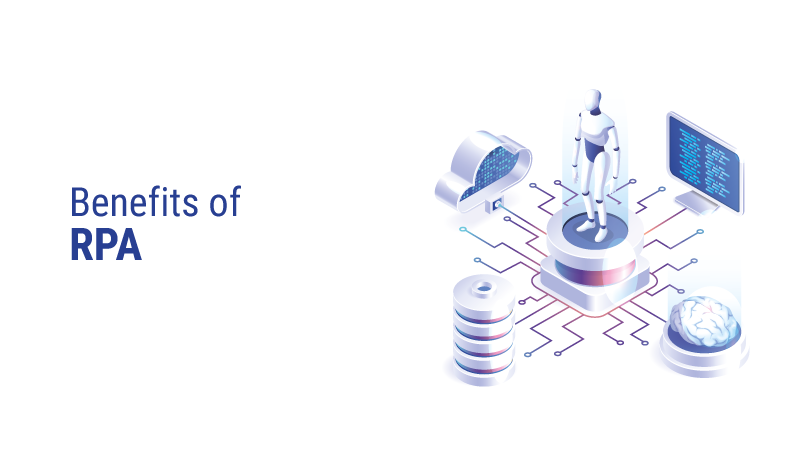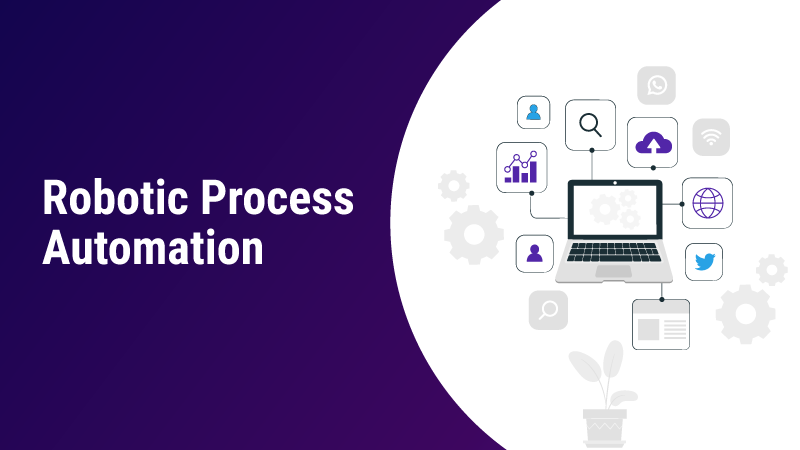Benefits of Robotic Process Automation

Introduction
Robots have always been looked at with curiosity and wonder, not just because of their speed and accuracy, but also because of their ability to mimic human actions. We have seen robots doing many things from cleaning to assisting. But have you ever imagined the advantages or benefits they would offer if implemented in areas where human employees fail to give their 100%?
Well, that’s what we are going to discuss here.
What is Robotic Process Automation (RPA)?
Robotic Process Automation (RPA) is a cutting-edge technology that facilitates the development, deployment, and control of software bots that imitate human actions and interact with digital systems and software. RPA is one of the newly emerged trending technologies that has already established its position in enhancing the productivity of organizations by utilizing already existing methodologies. It enables automating tedious, mundane, and standardized tasks that were considered to be performed by human workers only. RPA generates productivity and value with minimal investment.
Basically, RPA can be defined as a ‘software bot’ that allows applications to analyze and interpret processes including data manipulation, initiating transactions, prompting responses, and interacting with multiple digital systems. Within a short period of time, RPA has gained popularity in various business sectors because of the ease it offers in the transaction of a huge volume of data and a number of benefits that no other technological innovation can offer. RPA, when integrated with other technologies like Artificial Intelligence and Machine Learning, can do things that are labeled as unapproachable.
Benefits of Robotic Process Automation
As we have discussed what RPA is, it is time to discuss the benefits RPA offers and what makes it stand out among other technologies. Here are some of the major benefits of RPA:
Cost-effective
It has been proven that RPA has helped in reducing the functional cost to 25% – 50%. This is because it demands only a one-time cost for the development and installation, followed by a maintenance charge. For hiring a manual worker there are certain specific charges that need to be paid every month. Manual employees should be given a salary package, overtime payment, insurance, and other benefits. The total cost of installing an RPA bot is still very less when compared to hiring a manual worker. Therefore, it is true that RPA is cost-effective.
Accuracy and quality
Good quality work is always appreciated by companies. Finishing a task with high accuracy is very important and rare because humans can make mistakes knowingly or unknowingly. Employees may get tired and may find it difficult to concentrate on a task for a long time. This may lead to errors in the task, which in turn affect the quality of the task assigned. RPA bots are programmed to perform tasks accurately without making errors and with 100% accuracy. They follow the rules correctly and thus do not make any errors. Less error indicates high quality.
Low technical barriers
RPA is very simple and can be easily handled even by non-technical programmers. It does not require proficiency in software technology or technical expertise.
High scalability
Scalability is a feature of RPA. It can be adapted according to the changing needs of the business. RPA enables businesses to easily scale activities upwards or downwards as required, thus ensuring companies make changes from time to time.
High operational efficiency and productivity
Unlike manual laborers, RPA bots can function 24/7 without any break. Human workers require regular intervals to take rest because our body is not designed to function the whole day long. Since RPA bots display high operational efficiency due to their speed, accuracy, and quality, they automatically increase the productivity of an organization.
Better customer experience
Since all the tasks are performed with high efficiency and accuracy, clients get the output they desire for. RPA takes very little time to complete tasks and deliver high-quality services. This takes the customer satisfaction level to a greater extent. Moreover, robotic automation assists customers to perform certain tasks by themselves with the help of chatbots. It also helps in eliminating customer pain; for example, customers may face problems while applying for loans – filling different forms, submitting documents, verification, approval, loan status – with RPA, the whole procedure will be completed within a few days due to absence of multiple human touchpoints.
Increased employee productivity
RPA bots take up routine and time-consuming tasks performed by manual workers. Robotic Process Automation not only frees the employees from boring tasks but also enables them to concentrate on tasks that actually require human intelligence.
Increased ROI
Once you have implemented RPA, you will see a spike in Return on Investment with a decrease in functional cost. While most of the IT advancements make you wait for an increase in ROI, RPA aims to deliver results within a short period of time.
Easy integration
It is very easy to integrate RPA with existing systems. There are certain technologies that need complete replacement of the entire working system for smooth integration. Moreover, RPA bots can be integrated with multiple systems at the same time.
Business sectors using RPA
RPA is not specific or limited to any business sector. It can be implemented wherever automation is necessary. Some of the major sectors that use RPA include:
- Education sector
- Human Resources
- Manufacturing
- Insurance
- Banking and finance
- Health care
- Customer care
- E-commerce
- Oil and gas industry, etc.
Wrap Up
Though RPA has been introduced to reduce the workload of human laborers, it has been misinterpreted as a ‘job taker’. Many believe that Robotic Process Automation is aimed at replacing manual workers with bots to increase productivity and efficiency. It is true that the efficiency and functionality of RPA bots cannot be compared with human workers but they are not intended to replace human workers. The creativity and intelligence of humans are essential to perform many other complex tasks. RPA enables companies from different industries to complete various tasks in less time and at a low cost. They are capable of providing the necessary requirements for your company to take your business to the next level in no time.
Get Started with our RPA ServicesBlogs by Category
AppForms Artificial Intelligence Blockchain Call Centers Chatbots Cloud Computing Data Management Design Digital Marketing Digital Transformation Enterprise Applications FinTech Insights LowCode Development Microsoft Mobile Apps News Office 365 Robotic Process Automation Security SharePoint Software Development Web ApplicationWhat is Robotic Process Automation? RPA Explained

2024-05-23 16:56:57